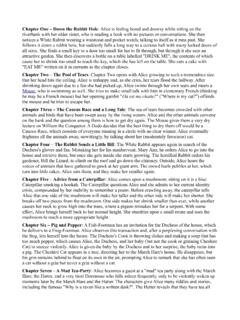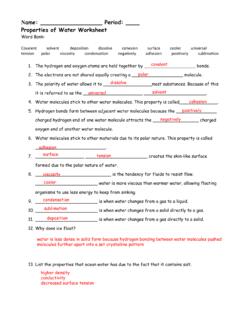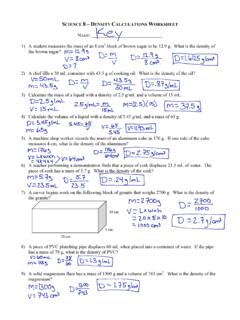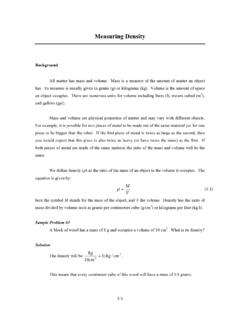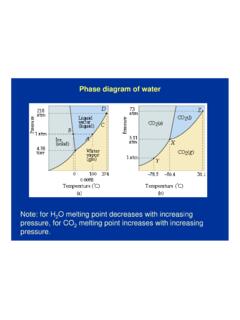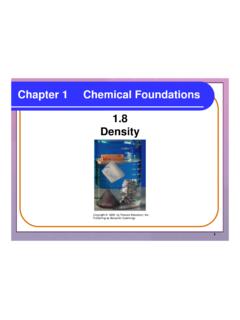Transcription of Water’s Polarity - City University of New York
1 |WaterBy the end of this section, you will be able to: Describe the properties of water that are critical to maintaining life Explain why water is an excellent solvent Provide examples of water s cohesive and adhesive properties Discuss the role of acids, bases, and buffers in homeostasisWhy do scientists spend time looking for water on other planets? Why is water so important? It isbecause water is essential to life as we know it. water is one of the more abundant molecules and theone most critical to life on Earth. Approximately 60 70 percent of the human body is made up of it, life as we know it simply would not Polarity of the water molecule and its resulting hydrogen bonding make water a unique substancewith special properties that are intimately tied to the processes of life. Life originally evolved in awatery environment, and most of an organism s cellular chemistry and metabolism occur inside thewatery contents of the cell s cytoplasm.
2 Special properties of water are its high heat capacity and heatof vaporization, its ability to dissolve polar molecules, its cohesive and adhesive properties, and itsdissociation into ions that leads to the generation of pH. Understanding these characteristics of waterhelps to elucidate its importance in maintaining s PolarityOne of water s important properties is that it is composed of polar molecules: the hydrogen and oxygenwithin water molecules (H2O) form polar covalent bonds. While there is no net charge to a watermolecule, the Polarity of water creates a slightly positive charge on hydrogen and a slightly negativecharge on oxygen, contributing to water s properties of attraction. water s charges are generated becauseoxygen is more electronegative than hydrogen, making it more likely that a shared electron would befound near the oxygen nucleus than the hydrogen nucleus, thus generating the partial negative chargenear the a result of water s Polarity , each water molecule attracts other water molecules because of theopposite charges between water molecules, forming hydrogen bonds.
3 water also attracts or is attractedto other polar molecules and ions. A polar substance that interacts readily with or dissolves in water isreferred to as (hydro- = water ; -philic = loving ). In contrast, non-polar molecules suchas oils and fats do not interact well with water , as shown in and separate from it rather thandissolve in it, as we see in salad dressings containing oil and vinegar (an acidic water solution). Thesenonpolar compounds are called (hydro- = water ; -phobic = fearing ).CHAPTER 2 | THE CHEMICAL FOUNDATION OF LIFE 53 Figure and water do not mix. As this macro image of oil and water shows, oil does notdissolve in water but forms droplets instead. This is due to it being a nonpolar compound. (credit:Gautam Dogra). water s States: Gas, liquid , and SolidThe formation of hydrogen bonds is an important quality of the liquid water that is crucial to life aswe know it.
4 As water molecules make hydrogen bonds with each other, water takes on some uniquechemical characteristics compared to other liquids and, since living things have a high water content,understanding these chemical features is key to understanding life. In liquid water , hydrogen bonds areconstantly formed and broken as the water molecules slide past each other. The breaking of these bondsis caused by the motion (kinetic energy) of the water molecules due to the heat contained in the the heat is raised as water is boiled, the higher kinetic energy of the water molecules causes thehydrogen bonds to break completely and allows water molecules to escape into the air as gas (steam orwater vapor). On the other hand, when the temperature of water is reduced and water freezes, the watermolecules form a crystalline structure maintained by hydrogen bonding (there is not enough energy tobreak the hydrogen bonds) that makes ice less dense than liquid water , a phenomenon not seen in thesolidification of other s lower density in its solid form is due to the way hydrogen bonds are oriented as it freezes: thewater molecules are pushed farther apart compared to liquid water .
5 With most other liquids, solidificationwhen the temperature drops includes the lowering of kinetic energy between molecules, allowing themto pack even more tightly than in liquid form and giving the solid a greater density than the lower density of ice, illustrated and pictured in , an anomaly, causes it to float at thesurface of liquid water , such as in an iceberg or in the ice cubes in a glass of ice water . In lakes and ponds,ice will form on the surface of the water creating an insulating barrier that protects the animals and plantlife in the pond from freezing. Without this layer of insulating ice, plants and animals living in the pondwould freeze in the solid block of ice and could not survive. The detrimental effect of freezing on livingorganisms is caused by the expansion of ice relative to liquid water . The ice crystals that form uponfreezing rupture the delicate membranes essential for the function of living cells, irreversibly damagingthem.
6 Cells can only survive freezing if the water in them is temporarily replaced by another liquid CHAPTER 2 | THE CHEMICAL FOUNDATION OF LIFEThis content is available for free at bonding makes ice less dense than liquid water . The (a) lattice structure of icemakes it less dense than the freely flowing molecules of liquid water , enabling it to (b) float on water .(credit a: modification of work by Jane Whitney, image created using Visual Molecular Dynamics(VMD) software[1]; credit b: modification of work by Carlos Ponte)Click to see a 3-D animation of the structure ofan ice lattice. (Image credit: Jane Whitney. Image created using Visual Molecular Dynamics VMDsoftware.[2]) water s High Heat CapacityWater s high heat capacity is a property caused by hydrogen bonding among water molecules. Waterhas the highest of any liquids.
7 Specific heat is defined as the amount of heat onegram of a substance must absorb or lose to change its temperature by one degree Celsius. For water , thisamount is one . It therefore takes water a long time to heat and long time to cool. In fact, thespecific heat capacity of water is about five times more than that of sand. This explains why the landcools faster than the sea. Due to its high heat capacity, water is used by warm blooded animals to moreevenly disperse heat in their bodies: it acts in a similar manner to a car s cooling system, transportingheat from warm places to cool places, causing the body to maintain a more even s Heat of VaporizationWater also has a high , the amount of energy required to change one gram of aliquid substance to a gas. A considerable amount of heat energy (586 cal) is required to accomplishthis change in water .
8 This process occurs on the surface of water . As liquid water heats up, hydrogenbonding makes it difficult to separate the liquid water molecules from each other, which is required forit to enter its gaseous phase (steam). As a result, water acts as a heat sink or heat reservoir and requiresmuch more heat to boil than does a liquid such as ethanol (grain alcohol), whose hydrogen bondingwith other ethanol molecules is weaker than water s hydrogen bonding. Eventually, as water reaches itsboiling point of 100 Celsius (212 Fahrenheit), the heat is able to break the hydrogen bonds betweenthe water molecules, and the kinetic energy (motion) between the water molecules allows them to escapefrom the liquid as a gas. Even when below its boiling point, water s individual molecules acquire enoughenergy from other water molecules such that some surface water molecules can escape and vaporize: thisprocess is known as.
9 1. W. Humphrey W., A. Dalke, and K. Schulten, VMD Visual Molecular Dynamics, Journal of Molecular Graphics 14(1996): W. Humphrey W., A. Dalke, and K. Schulten, VMD Visual Molecular Dynamics, Journal of Molecular Graphics 14(1996): 2 | THE CHEMICAL FOUNDATION OF LIFE 55 The fact that hydrogen bonds need to be broken for water to evaporate means that a substantial amountof energy is used in the process. As the water evaporates, energy is taken up by the process, cooling theenvironment where the evaporation is taking place. In many living organisms, including in humans, theevaporation of sweat, which is 90 percent water , allows the organism to cool so that homeostasis of bodytemperature can be s Solvent PropertiesSince water is a polar molecule with slightly positive and slightly negative charges, ions and polarmolecules can readily dissolve in it.
10 Therefore, water is referred to as a , a substance capable ofdissolving other polar molecules and ionic compounds. The charges associated with these molecules willform hydrogen bonds with water , surrounding the particle with water molecules. This is referred to as a , or a hydration shell, as illustrated in and serves to keep the particlesseparated or dispersed in the ionic compounds are added to water , the individual ions react with the polar regions of thewater molecules and their ionic bonds are disrupted in the process of . Dissociation occurswhen atoms or groups of atoms break off from molecules and form ions. Consider table salt (NaCl, orsodium chloride): when NaCl crystals are added to water , the molecules of NaCl dissociate into Na+and Cl ions, and spheres of hydration form around the ions, illustrated in.





